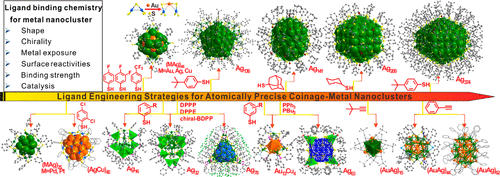当前位置:
X-MOL 学术
›
Acc. Chem. Res.
›
论文详情
Our official English website, www.x-mol.net, welcomes your
feedback! (Note: you will need to create a separate account there.)
Surface Chemistry of Atomically Precise Coinage–Metal Nanoclusters: From Structural Control to Surface Reactivity and Catalysis
Accounts of Chemical Research ( IF 16.4 ) Pub Date : 2018-11-15 00:00:00 , DOI: 10.1021/acs.accounts.8b00371 Juanzhu Yan 1 , Boon K. Teo 1 , Nanfeng Zheng 1
Accounts of Chemical Research ( IF 16.4 ) Pub Date : 2018-11-15 00:00:00 , DOI: 10.1021/acs.accounts.8b00371 Juanzhu Yan 1 , Boon K. Teo 1 , Nanfeng Zheng 1
Affiliation

|
A comprehensive understanding of chemical bonding and reactions at the surface of nanomaterials is of great importance in the rational design of their functional properties and applications. With the rapid development in cluster science, it has become clear that atomically precise metal clusters represent ideal models for resolving various important and/or unsolved issues related to surface science. This Account highlights our recent efforts on the fabrication of ligand-stabilized coinage nanoclusters with atomic precision from the viewpoint of surface coordination chemistry in particular. The successful synthesis of a large variety of metal clusters in our group has greatly benefitted from the development of an effective amine-assisted NaBH4 reduction method. First discussed in this Account is how the introduction of amines in the synthetic protocol enhances the long-term stability and high-yield production of Ag/Cu-based metals in air. Such a method allows the utilization of different organic ligands as surface stabilizing agents to manipulate both the core and surface structures of metal nanoclusters, helping to understand the role of surface ligands in determining the structures of metal nanoclusters. The coordination chemistry of ligands used in the synthesis of metal nanoclusters is crucial in determining their overall shape, metal arrangement, surface ligand binding structure, chirality and also metal exposure. Detailed discussions are given in the following four different systems: (1) The co-use of phosphines and thiolates with rich coordination structures (2 to 4-coordinated) helps to control the formation of a sequence of Ag nanoclusters with a near-perfectly cubic shape; (2) The metal arrangements and surface structures of AuCu clusters highly depend on metal precursors and counter cations used in the synthesis; (3) Metal clusters with intrinsic chirality are readily prepared by introducing chiral ligands or counterions, making it possible to obtain optically active enantiomers and understand the origin of chirality of metal nanoclusters; (4) The variation of metal exposure of the inner metal core of metal nanocluster can be controlled by the surface ligand coordination structure. Such capabilities to manipulate the surface structure of metal nanoclusters allow the creation of model systems for investigating the structure–reactivity relationship of metal nanomaterials. Several important examples are then discussed to highlight the importance of ligand coordination chemistry in tuning the surface reactivity and catalysis of metal nanoclusters. For example, bulky thiolates on Ag are demonstrated to be more labile than small thiolates for making metal nanoclusters with both enhanced ligand exchange capability and catalysis. Alkynyl ligands can be thermally released from metal nanoclusters more easily than thiolates and halides while maintaining the overall structure, thereby serving as ideal systems for understanding the promoting effect of surface stabilizers on catalysis. Finally, we provide a perspective on the principles of surface coordination chemistry of metal nanoclusters and their potential applications with regards to catalysis of protected metal clusters.
中文翻译:

原子精确造币-金属纳米簇的表面化学:从结构控制到表面反应性和催化
全面了解纳米材料表面的化学键和反应在合理设计其功能特性和应用方面非常重要。随着团簇科学的快速发展,很明显,原子精确的金属团簇代表了解决与表面科学有关的各种重要和/或未解决问题的理想模型。该帐户特别从表面配位化学的角度突出了我们最近在以原子精度制造配体稳定的硬币纳米簇的过程中所做的努力。我们小组中成功合成了多种金属簇,这得益于有效胺辅助NaBH 4的开发。还原法。该帐户中首先讨论的是在合成方案中引入胺如何增强空气中基于Ag / Cu的金属的长期稳定性和高产量。这种方法允许利用不同的有机配体作为表面稳定剂来操纵金属纳米团簇的核心和表面结构,从而有助于了解表面配体在确定金属纳米团簇结构中的作用。金属纳米团簇的合成中所用配体的配位化学对于确定其整体形状,金属排列,表面配体结合结构,手性以及金属暴露至关重要。在以下四个不同的系统中进行了详细的讨论:(1)膦和硫醇盐具有丰富的配位结构(2至4配位)的共同使用有助于控制几乎完美立方形状的Ag纳米团簇的形成;(2)AuCu团簇的金属排列和表面结构高度依赖于合成中使用的金属前体和抗衡阳离子;(3)通过引入手性配体或抗衡离子可以容易地制备具有固有手性的金属团簇,从而可以获得旋光对映体并了解金属纳米团簇的手性来源。(4)可以通过表面配体配位结构来控制金属纳米团簇的内部金属核的金属暴露量的变化。这种操纵金属纳米团簇表面结构的能力允许创建用于研究金属纳米材料的结构-反应关系的模型系统。然后讨论了几个重要的例子,以突出配体配位化学在调节金属纳米团簇的表面反应性和催化作用中的重要性。例如,事实证明,Ag上的大体积硫醇盐比小硫醇盐更不稳定,可用于制造具有增强的配体交换能力和催化作用的金属纳米簇。与硫醇盐和卤化物相比,炔基配体可以更容易地从金属纳米簇中热释放,同时保持整体结构,从而成为了解表面稳定剂对催化作用的理想系统。最后,
更新日期:2018-11-15
中文翻译:

原子精确造币-金属纳米簇的表面化学:从结构控制到表面反应性和催化
全面了解纳米材料表面的化学键和反应在合理设计其功能特性和应用方面非常重要。随着团簇科学的快速发展,很明显,原子精确的金属团簇代表了解决与表面科学有关的各种重要和/或未解决问题的理想模型。该帐户特别从表面配位化学的角度突出了我们最近在以原子精度制造配体稳定的硬币纳米簇的过程中所做的努力。我们小组中成功合成了多种金属簇,这得益于有效胺辅助NaBH 4的开发。还原法。该帐户中首先讨论的是在合成方案中引入胺如何增强空气中基于Ag / Cu的金属的长期稳定性和高产量。这种方法允许利用不同的有机配体作为表面稳定剂来操纵金属纳米团簇的核心和表面结构,从而有助于了解表面配体在确定金属纳米团簇结构中的作用。金属纳米团簇的合成中所用配体的配位化学对于确定其整体形状,金属排列,表面配体结合结构,手性以及金属暴露至关重要。在以下四个不同的系统中进行了详细的讨论:(1)膦和硫醇盐具有丰富的配位结构(2至4配位)的共同使用有助于控制几乎完美立方形状的Ag纳米团簇的形成;(2)AuCu团簇的金属排列和表面结构高度依赖于合成中使用的金属前体和抗衡阳离子;(3)通过引入手性配体或抗衡离子可以容易地制备具有固有手性的金属团簇,从而可以获得旋光对映体并了解金属纳米团簇的手性来源。(4)可以通过表面配体配位结构来控制金属纳米团簇的内部金属核的金属暴露量的变化。这种操纵金属纳米团簇表面结构的能力允许创建用于研究金属纳米材料的结构-反应关系的模型系统。然后讨论了几个重要的例子,以突出配体配位化学在调节金属纳米团簇的表面反应性和催化作用中的重要性。例如,事实证明,Ag上的大体积硫醇盐比小硫醇盐更不稳定,可用于制造具有增强的配体交换能力和催化作用的金属纳米簇。与硫醇盐和卤化物相比,炔基配体可以更容易地从金属纳米簇中热释放,同时保持整体结构,从而成为了解表面稳定剂对催化作用的理想系统。最后,











































 京公网安备 11010802027423号
京公网安备 11010802027423号